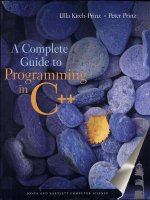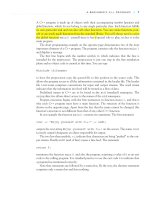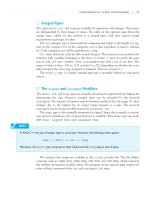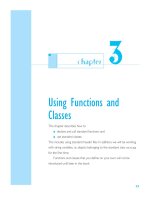A Complete Guide to Programming in C++ part 14 pps
Bạn đang xem bản rút gọn của tài liệu. Xem và tải ngay bản đầy đủ của tài liệu tại đây (210.68 KB, 10 trang )
CONDITIONAL EXPRESSIONS
■
109
ᮀ Conditional Operator
The conditional operator ?: is used to form an expression that produces either of two
values, depending on the value of some condition. Because the value produced by such
an expression depends on the value of a condition, it is called conditional expression.
In contrast to the if-else statement the selection mechanism is based on expres-
sions: one of two possible expressions is selected. Thus, a conditional expression is often
a concise alternative to an if-else statement.
Syntax: expression ? expression1 : expression2
expression
is evaluated first. If the result is true, expression1 is evaluated; if not
expression2 is executed. The value of the conditional expression is therefore either
the value of expression1 or expression2.
Example: z = (a >= 0) ? a : -a;
This statement assigns the absolute value of a to the variable z. If a has a positive value
of 12, the number 12 is assigned to z. But if a has a negative value, for example –8, the
number 8 is assigned to z.
Since this sample program stores the value of the conditional expression in the vari-
able z, the statement is equivalent to
if( a > 0 )
z = a;
else
z = -a;
ᮀ Precedence
The conditional operator is the only C++ operator with three operands. Its precedence is
higher than that of the comma and assignment operators but lower than all other opera-
tors. In other words, you could omit the brackets in the first example.
You can use the result of a conditional evaluation without assigning it, as the sample
program on the opposite page shows. In this example, x is printed on screen if x is
greater than y, and y is printed otherwise.
However, you should assign the result of complex expressions to a variable explicitly
to improve the readability of your program.
110
■
CHAPTER 6 CONTROL FLOW
case Const1:
case Const2:
statements
break
statements
break
statements
break
default:
. . .
switch(expression)
// Evaluates given input.
int command = menu(); // The function menu() reads
// a command.
switch( command ) // Evaluate command.
{
case 'a':
case 'A':
action1(); // Carry out 1st action.
break;
case 'b':
case 'B':
action2(); // Carry out 2nd action.
break;
default:
cout << '\a' << flush; // Beep on
} // invalid input
■
SELECTING WITH switch
Structogram for the switch statement
Example
SELECTING WITH SWITCH
■
111
ᮀ The switch Statement
Just like the else-if chain, the switch statement allows you to choose between mul-
tiple alternatives. The switch statement compares the value of one expression with
multiple constants.
switch( expression )
{
case const1: [ statement ]
[ break; ]
case const2: [ statement ]
[ break; ]
.
.
.
[default: statement ]
}
First, the expression in the switch statement is evaluated. It must be an integral
type. The result is then compared to the constants, const1, const2, , in the case
labels. The constants must be different and can only be integral types (boolean values
and character constants are also integral types).
If the value of an expression matches one of the case constants, the program
branches to the appropriate case label. The program then continues and the case labels
lose their significance.
You can use break to leave the switch statement unconditionally. The statement is
necessary to avoid executing the statements contained in any case labels that follow.
If the value of the expression does not match any of the case constants, the program
branches to the default label, if available. If you do not define a default label, noth-
ing happens. The default does not need to be the last label; it can be followed by addi-
tional case labels.
ᮀ Differences between switch and else-if Chains
The else-if chain is more versatile than the switch statement. Every selection can
be programmed using an else-if chain. But you will frequently need to compare the
value of an integral expression with a series of possible values. In this case (and only this
case), you can use a switch statement.
As the example opposite shows, a switch statement is more easily read than an
equivalent else-if chain, so use the switch statement whenever possible.
112
■
CHAPTER 6 CONTROL FLOW
As long as expression is true
break;
statement, which follows the loop.
// ascii.cpp : To output an ASCII Code Table
#include <iostream>
#include <iomanip>
using namespace std;
int main()
{
int ac = 32; // To begin with ASCII Code 32
// without control characters.
while(true)
{ cout << "\nCharacter Decimal Hexadecimal\n\n";
int upper;
for( upper =ac + 20; ac < upper && ac < 256; ++ac)
cout << " " << (char)ac // as character
<< setw(10) << dec << ac
<< setw(10) << hex << ac << endl;
if( upper >= 256) break;
cout <<"\nGo on -> <return>,Stop -> <q>+<return>";
char answer;
cin.get(answer);
if( answer == 'q' || answer == 'Q' )
break;
cin.sync(); // Clear input buffer
}
return 0;
}
The expression (char)ac yields the value ac of type char.
✓
NOTE
■
JUMPS WITH break, continue, AND goto
Structogram for break within a while statement
Sample program containing a
break statement
JUMPS WITH BREAK, CONTINUE, AND GOTO
■
113
ᮀ break
The break statement exits from a switch or loop immediately. You can use the break
keyword to jump to the first statement that follows the switch or loop.
The program on the opposite page, which outputs a group of 20 ASCII characters and
their corresponding codes, uses the break keyword in two places. The first break exits
from an infinite while(true) { } loop when a maximum value of 256 has been
reached. But the user can also opt to continue or terminate the program. The second
break statement is used to terminate the while loop and hence the program.
ᮀ continue
The continue statement can be used in loops and has the opposite effect to break,
that is, the next loop is begun immediately. In the case of a while or do-while loop
the program jumps to the test expression, whereas a for loop is reinitialized.
Example: for( int i = 0; i < 100; i++ )
{
. . . // Processes all integers.
if( i % 2 == 1)
continue;
. . . // Process even
// numbers only.
}
ᮀ goto and Labels
C++ also offers a goto statement and labels. This allows you to jump to any given point
marked by a label within a function. For example, you can exit from a deeply embedded
loop construction immediately.
Example: for( . . . )
for( . . . )
if (error) goto errorcheck;
. . .
errorcheck: . . . // Error handling
A label is a name followed by a colon. Labels can precede any statement.
Any program can do without goto statements. If you need to use a goto statement,
do so to exit from a code block, but avoid entering code blocks by this method.
exercises
114
■
CHAPTER 6 CONTROL FLOW
12345678910
1
2
3
4
5
6
7
8
9
10
1
2
10
2
4
20
3
6
30
.
.
.
.
.
.
.
.
.
10
20
100
.
.
.
. . . . . .
. . . . . .
****** ******
MULTIPLICATION TABLE
■
EXERCISES
Screen output for exercise 2
Note on exercise 4
Use the function time() to initialize the random number generator:
#include <time.h> // Prototype of time()
#include <stdlib.h> // Prototypes of srand()
// and rand()
long sec;
time( &sec ); // Take the number of seconds and
srand( (unsigned)sec ); // use it to initialize.
EXERCISES
■
115
Use the system time to seed the random number generator as shown opposite. The time() function
returns the number of seconds since 1/1/1970, 0:0. The long value of the sec variable is converted to
unsigned by unsigned(sec) and then passed to the srand() function.
✓
NOTE
Exercise 1
Rewrite the EuroDoll.cpp program in this chapter to replace both the for
loops with while loops.
Exercise 2
Write a C++ program that outputs a complete multiplication table (as shown
opposite) on screen.
Exercise 3
Write a C++ program that reads an integer between 0 and 65535 from the
keyboard and uses it to seed a random number generator.Then output 20
random numbers between 1 and 100 on screen.
Exercise 4
Write a program for the following numerical game:
The computer stores a random number between 1 and 15 and the player
(user) attempts to guess it.The player has a total of three attempts.After each
wrong guess, the computer tells the user if the number was too high or too low.
If the third attempt is also wrong, the number is output on screen.
The player wins if he or she can guess the number within three attempts.
The player is allowed to repeat the game as often as he or she wants.
solutions
116
■
CHAPTER 6 CONTROL FLOW
■
SOLUTIONS
Exercise 1
The for loops of program EuroDoll.cpp are equivalent to the following while
loops:
// The outer loop sets the lower
// limit and the step width used:
lower=1, step=1;
while( lower <= maxEuro)
{
// The inner loop outputs a block:
euro = lower;
upper = step*10;
while( euro <= upper && euro <= maxEuro)
{
cout << setw(12) << euro
<< setw(20) << euro*rate << endl;
euro += step;
}
step *= 10, lower = 2*step;
}
Exercise 2
// MultTable.cpp
// Outputs a multiplication table.
#include <iostream>
#include <iomanip>
using namespace std;
int main()
{
int factor1, factor2;
cout << "\n\n "
<< " ****** MULTIPLICATION TABLE ******"
<< endl;
// Outputs the first and second line:
cout << "\n\n\n "; // 1. line
for( factor2 = 1 ; factor2 <= 10 ; ++factor2 )
cout << setw(5) << factor2;
cout << "\n " // 2. line
<< " "
<< endl;
SOLUTIONS
■
117
// Outputs the remaining lines of the table:
for( factor1 = 1 ; factor1 <= 10 ; ++factor1 )
{
cout << setw(6) << factor1 << " |";
for( factor2 = 1 ; factor2 <= 10 ; ++factor2 )
cout << setw(5) << factor1 * factor2;
cout << endl;
}
cout << "\n\n\n"; // To shift up the table
return 0;
}
Exercise 3
// random.cpp
// Outputs 20 random numbers from 1 to 100.
#include <stdlib.h> // Prototypes of srand() and rand()
#include <iostream>
#include <iomanip>
using namespace std;
int main()
{
unsigned int i, seed;
cout << "\nPlease type an integer between "
"0 and 65535: ";
cin >> seed; // Reads an integer.
srand( seed); // Seeds the random
// number generator.
cout << "\n\n "
"****** RANDOM NUMBERS ******\n\n";
for( i = 1 ; i <= 20 ; ++i)
cout << setw(20) << i << ". random number = "
<< setw(3) << (rand() % 100 + 1) << endl;
return 0;
}
118
■
CHAPTER 6 CONTROL FLOW
Exercise 4
// NumGame.cpp : A numerical game against the computer
#include <cstdlib> // Prototypes of srand() and rand()
#include <ctime> // Prototype of time()
#include <iostream>
using namespace std;
int main()
{
int number, attempt;
char wb = 'r'; // Repeat or finish.
long sec;
time( &sec); // Get the time in seconds.
srand((unsigned)sec); // Seeds the random
// number generator
cout << "\n\n "
<< " ******* A NUMERICAL GAME *******" << endl;
cout << "\n\nRules of the game:" << endl;
while( wb == 'r')
{
cout << "I have a number between 1 and 15 in mind \n"
<< "You have three chances to guess correctly!\n"
<< endl;
number = (rand() % 15) + 1;
bool found = false; int count = 0;
while( !found && count < 3 )
{
cin.sync(); // Clear input buffer
cin.clear();
cout << ++count << ". attempt: ";
cin >> attempt;
if(attempt < number) cout << "too small!"<< endl;
else if(attempt > number) cout <<"too big!"<< endl;
else found = true;
}
if( !found)
cout << "\nI won!"
<< " The number in question was: "
<< number << endl;
else
cout << "\nCongratulations! You won!" << endl;
cout << "Repeat —> <r> Finish —> <f>\n";
do
cin.get(wb);
while( wb != 'r' && wb != 'f');
}
return 0;
}









